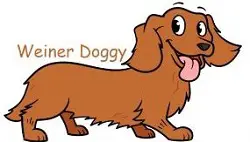A sable dachshund is a specific color variant of the Dachshund breed of dog. Guide to the sable and the differences between other varieties of wiener.
In dogs, “sable” refers to a coat pattern where each individual hair has multiple colors, usually with darker tips and a lighter base.
For sable dachshunds, this results in a coat that may appear to change color or have different shades in various lighting conditions.
Physically, they are similar to other Dachshunds: small, long-bodied, and with short legs and are known for being brave, curious, and quite tenacious.
The sable coat pattern is just one of many found in Dachshunds. They can also be found in a variety of other colors and patterns, including solid, dapple and piebald.
What Colors Of Sable Dachshund Are There?
The sable coat pattern in dachshunds can appear in a variety of base colors, but the defining characteristic of the sable pattern is the presence of darker tips on the hairs over a lighter base color.
Some common base colors in which the sable pattern may be found in dachshunds:
Red Sable
The most common sable color, where the dog has a red or reddish coat with black-tipped hairs.
The overall appearance may range from a deep, rich red to a lighter, more golden hue, depending on the individual dog and the distribution of sable patterning.
Black and Tan Sable
In this variation, the dog has a black base with tan markings, and the sable patterning may be present primarily on the tan parts, giving those areas a shaded or gradient effect.
Chocolate Sable
Similar to red sable but with a chocolate or brown base color. These dogs will have chocolate brown hair with darker brown or black tips.
Cream Sable
Less common, this variation features a cream-colored coat with darker tips. The contrast may be more subtle compared to darker base colors.
Sable Dachshund Varieties
Sable dachshunds, like all dachshunds, come in three coat types: smooth, long-haired, and wire-haired.
Each coat type can present the sable pattern in unique ways, affecting the dog’s appearance and grooming needs.
Additionally, the sable pattern can be combined with other patterns and markings, leading to a wide range of appearances even within the sable category.
Smooth Coat Sable Dachshund
Smooth coat sables have a sleek, short coat where the sable pattern can give a subtle yet striking effect.
The dark-tipped hairs over a lighter base are visible but may not be as pronounced as in the long-haired variety.
Low maintenance in terms of grooming compared to the other coat types. Regular brushing is sufficient to keep the coat healthy.
Long-Haired Sable Dachshund
This variety showcases the sable pattern most dramatically. Their longer fur allows the dark tips to contrast more vividly against the lighter base, often creating a stunning, flowing look.
The sable effect can be particularly noticeable on the ears, around the neck (ruff), and on the tail.
Requires more frequent grooming to prevent tangles and mats. Regular brushing and occasional baths are necessary to maintain the coat’s condition.
Wire-Haired Sable Dachshund
Wire-haired sables have a coarse, wiry outer coat with a softer undercoat. The sable pattern may be less noticeable than in long-haired varieties due to the texture of the coat but can still provide a unique coloration and texture.
They require regular brushing and professional grooming a few times a year to strip (remove dead hair from) their coat.
Pattern Variations
Solid Sable
A single base color with the sable pattern. This is the most straightforward expression of sable, where the entire coat shows the characteristic darker tips over a lighter base.
Sable with Markings
Sable Dachshunds may also have other typical dachshund markings, such as dapple (merle), brindle, or piebald patterns, combined with the sable coloring. These combinations can result in very unique and varied appearances.
Coat Type
Smooth and Long-Haired Varieties
The sable pattern’s visual impact varies greatly between these two because of the fur length, with long-haired individuals often showing a more pronounced sable effect.
Wire-Haired Variety
The texture of the wire-haired coat can make the sable pattern less distinct, but it adds a unique ruggedness to their appearance.
Sable vs Standard Dachshund
Sable Dachshund
Sable dachshunds have fur with a lighter base color that darkens towards the tip of each hair, giving them a distinct, gradient-like appearance. This pattern can be present in both standard and miniature sizes of Dachshunds.
The sable pattern gives these dachshunds a unique look, with a sort of shaded effect that can vary significantly in visibility depending on the dog’s base coat color and the lighting.
They can be found in all three coat types (smooth, long-haired, and wire-haired) and both main sizes (standard and miniature).
Standard Dachshund
Standard dachshunds are to the larger of the two main sizes. They typically weigh between 16 and 32 pounds, depending on their body length and overall condition.
They can come in a wide range of colors and patterns, including but not limited to solid colors, dapple, brindle, piebald, and yes, sable.
Originally bred for hunting badgers, hence their larger size and robust build compared to the miniature variety, which was bred for hunting smaller prey like rabbits.
The appearance will vary based on the specific color and pattern, but these dachshunds will not have the gradient-like sable effect on their coats.
Key Differences
The primary difference when comparing sable to standard in the context of color and pattern is the specific look of the coat.
Sable dachshunds have a distinctive shading effect due to the coloration of individual hairs, while standard color/pattern dachshunds will have a more uniform color distribution.
The sable pattern might be less common and less recognized by the general public compared to the traditional colors and patterns of dachshunds. This rarity can make sable dachshunds particularly appealing to enthusiasts and breeders.
Sable Dachshund Breeders & Puppies
Finding reputable breeders who specialize in sable Dachshunds or have sable puppies available requires some research and diligence.
It’s important to ensure that the breeder is ethical, responsible, and dedicated to the health and well-being of their dogs. Here are some tips on finding sable dachshund breeders and what to look for in a puppy:
Research Breeders
Start with national and regional breed clubs, such as the Dachshund Club of America (in the U.S.) or similar organizations in your country.
These clubs often have breeder directories or can offer referrals to reputable breeders.
Attending dog shows and breed-specific events can be a great way to meet breeders and see their dogs in person. This also gives you the opportunity to ask questions and learn more about the breed.
Evaluate the Breeder
Look for breeders who perform genetic and health testing on their breeding dogs to ensure they are free from common hereditary conditions that can affect dachshunds.
Reputable breeders will be open about their breeding practices, the health of their puppies, and the conditions in which their dogs are raised.
Good breeders offer ongoing support and advice to new puppy owners and are interested in the welfare of the dogs they breed throughout the dogs’ lives.
Puppy Considerations
Ensure the puppy has been health-checked by a vet, received appropriate vaccinations, and been dewormed according to their age.
Ask about the puppy’s socialization experiences. Puppies that have been well socialized from a young age are generally more adaptable and confident.
Don’t hesitate to ask the breeder questions about the puppy’s parents, health clearances, and temperament.
Avoiding Red Flags
These places often prioritize profit over the health and well-being of the animals. Puppies from these sources may have health and behavioral issues due to poor breeding practices and inadequate socialization.
While not all online listings are problematic, be cautious of breeders who sell puppies solely through online classifieds without any vetting process or personal interaction.
5. Commitment
Remember, adopting a puppy is a long-term commitment. Ensure you’re prepared for the responsibilities of dog ownership, including the specific needs of the dachshund breed.
Always prioritize finding a healthy, well-socialized puppy from an ethical source over seeking a specific color or pattern.
Main Image: Free Ads

